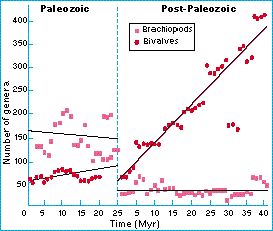Extinction and Radiation - What causes the rise and fall of a group?

An example: brachiopods
In the Palaeozoic, the dominant sessile filter-feeding invertebrate group was the brachiopods; they still survive to-day, but have largely been replaced by another taxonomic group, the bivalve molluscs. Gould and Calloway plotted the diversity changes of the two groups during the crucial period around the Permo-Triassic.
The bivalves, we can see, were increasing relative to the brachiopods during the Permian; they then suffered less than the brachiopods in the mass extinction at the end of the Permian, and since then the bivalves have expanded at a higher rate.
It is possible, therefore, that the replacement was due both to a competitive superiority of bivalves and to the better fortunes of the bivalves in the extraordinary conditions of the Permian mass extinction. Mass extinctions, by causing a temporary reduction in the level of competition, may lead to phases in which ecological replacements are particularly likely to occur.
In summary, we have considered two reasons why one higher taxon may replace another, and how to test which has operated. One is competitive displacement; it has often been put forward as a hypothesis, but is difficult to support with evidence. The rises and falls of higher taxa suggests that replacements often happen after the earlier group has gone extinct: the second group then radiates into the empty ecological space.
Figure: replacement of brachiopods by bivalves through the Permo-Triassic mass extinction. The bivalves were gaining before the mass extinction and survived through it relatively better. From Gould & Calloway (1980).
| Next |



